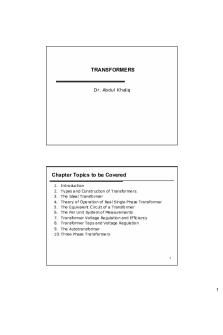K-Rated Transformer PDF

| Title | K-Rated Transformer |
|---|---|
| Course | Electrical Engineering |
| Institution | University of Rizal System |
| Pages | 5 |
| File Size | 243.8 KB |
| File Type | |
| Total Downloads | 66 |
| Total Views | 133 |
Summary
K-Rated Transformer...
Description
K-Factor Transformer, also known as K-Rated transformer, is designed for nonlinear or harmonic generating loads that a standard transformer could not adequately handle due to overheating. K-factor transformers are specially assembled with a double sized neutral conductor, heavier gauge copper and either change the geometry of their conductors or use multiple conductors for the coils. These properties allow them to endure the additional heat caused by harmonic currents much better than a standard transformer.
K – Factor or K – Rated Transformer
K-Factor It is an index of the transformer's ability to carry harmonic currents while operating within the temperature limits of its insulating system. K-Factor values range from 1 to 50. Standard transformers have a K-factor of 1.0 and are assigned for linear loads only. Meanwhile, a K-factor of 50 is utilized for the harshest harmonic condition possible.
Where:
Note: RMS current is the square root of the sum of squares of the individual currents.
The rationale is to first compute the K-factor of the load. Subsequently, specify the transformer to have a K-factor that is equal or higher than the calculated value. As a result, the transformer can be sized to the load without derating. Thus, transformers are said to be K-rated when they use the K-factor. There are different amounts of harmonic currents produced. The term for the total amount of harmonic current present is called "Total Harmonic Distortion (THD)". Since this value has a wide range, there needs to be an appropriate way to size the K-rated transformer to the load. This is where K-factor comes in. K-rated transformers have an associated K-factor rating. K-factor ratings range between 1 and 50. The higher the Kfactor, the more heat from harmonic currents the transformer is able to handle. A standard transformer that is designed for linear loads is said to have a K-factor of 1, whereas a transformer with a K-factor of 50 is designed for the harshest harmonic current environment possible. Transformers rated with K-factors of 40 and 50 are extremely rare, very expensive and generally are not used. Making the correct selection of K-factor is extremely important because it affects cost and safety. Calculations of harmonic content produces a precise value of K-factor, but power loads change constantly rendering the calculated value questionable. New construction installations have no data to assist in selecting the appropriate K-factor rating. In these cases, empirical data allows us to use past practices to obtain the correct K-factor rating. The table shows what K-factor rating to use when the electronic equipment represents a certain percentage of non-linear current. This table is based on past practices
Non-Linear Load
K-rating
Incidental electronic equipment representing...
Similar Free PDFs

Transformer Test report.docx
- 6 Pages

Transformer Project - 2018
- 5 Pages

Transformer Results - egbdnfcmk
- 3 Pages

transformer test report
- 6 Pages

Transformer Foundation Design
- 14 Pages

K-Rated Transformer
- 5 Pages

Transformer - Lecture notes 16-30
- 29 Pages
Popular Institutions
- Tinajero National High School - Annex
- Politeknik Caltex Riau
- Yokohama City University
- SGT University
- University of Al-Qadisiyah
- Divine Word College of Vigan
- Techniek College Rotterdam
- Universidade de Santiago
- Universiti Teknologi MARA Cawangan Johor Kampus Pasir Gudang
- Poltekkes Kemenkes Yogyakarta
- Baguio City National High School
- Colegio san marcos
- preparatoria uno
- Centro de Bachillerato Tecnológico Industrial y de Servicios No. 107
- Dalian Maritime University
- Quang Trung Secondary School
- Colegio Tecnológico en Informática
- Corporación Regional de Educación Superior
- Grupo CEDVA
- Dar Al Uloom University
- Centro de Estudios Preuniversitarios de la Universidad Nacional de Ingeniería
- 上智大学
- Aakash International School, Nuna Majara
- San Felipe Neri Catholic School
- Kang Chiao International School - New Taipei City
- Misamis Occidental National High School
- Institución Educativa Escuela Normal Juan Ladrilleros
- Kolehiyo ng Pantukan
- Batanes State College
- Instituto Continental
- Sekolah Menengah Kejuruan Kesehatan Kaltara (Tarakan)
- Colegio de La Inmaculada Concepcion - Cebu





![[13]-transformer design and principles](https://pdfedu.com/img/crop/172x258/eq53k3g813zr.jpg)


